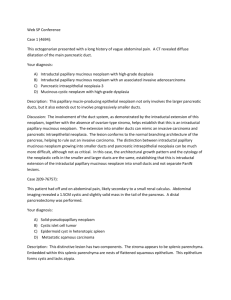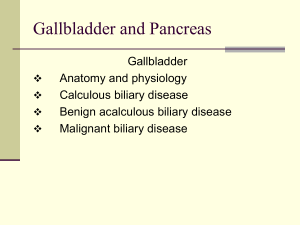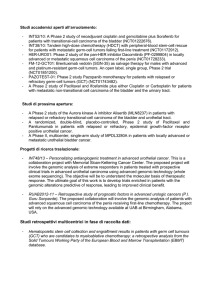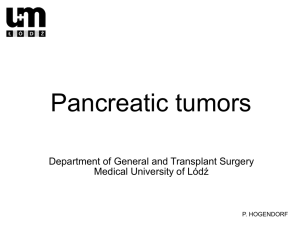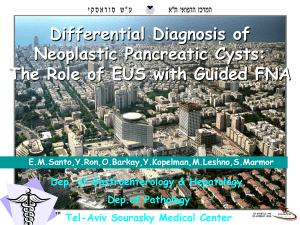Pancreatic Tumors: An Integrated Approach - IAP-AD
advertisement
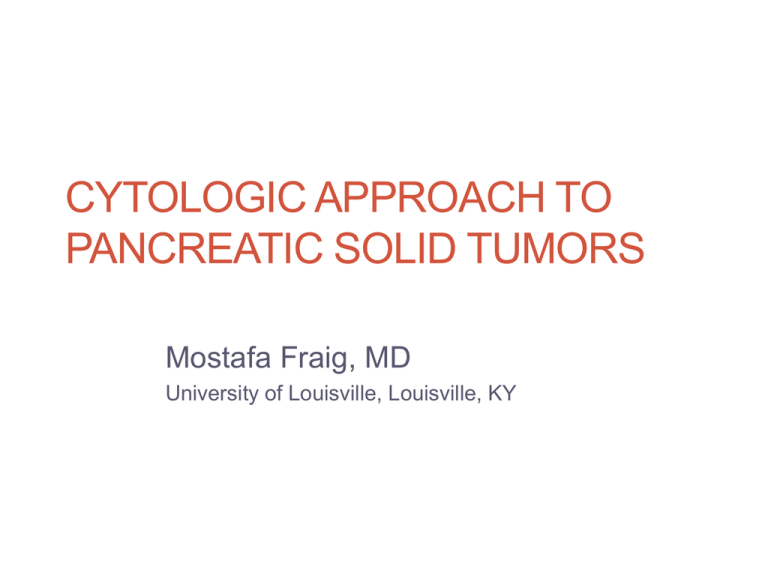
CYTOLOGIC APPROACH TO PANCREATIC SOLID TUMORS Mostafa Fraig, MD University of Louisville, Louisville, KY Overview • The integration of clinical and imaging findings. • The role of EUS and EUS-guided FNA. • Applying the integrated approach to cases and putting it together. Introduction: • Pancreatic cancer is common • Approximately 32,000 new cases are diagnosed every year. • The 5 year survival is 5% • The introduction of new imaging modalities means better and earlier detection. Now the size is down to around 1.0 CM. Classification of Pancreatic tumors: A- Soild Neoplasms: • Infiltrating ductal carcinoma and its variants • Tubular adenocarcinoma • Adenosquamous carcinoma • Colloid carcinoma • Signet ring cell carcinoma. • Hepatoid carcinoma. • Undifferentiated carcinoma. • Anaplastic carcinoma. • Sarcomaoid carcinoma. • Carcinosarcoma. • Undifferentiated carcioma with osteoclast-like giant cells Classification of Pancreatic tumors: Cont’d • Acinar cell carcinoma. • Endocrine neoplasms: • Well differentiated: functioning and non functioning • Poorly differentiated: small cell and large cell. • Soild pseudopapillary neoplasm. • Pancreatoblastoma. • Mixed tumors. B- Cystic neoplasms: • Serous cystic neoplasms. • Mucinous cystic neoplasms. • Intraductal neoplasms. EUS or Radiological Findings • Mass or cyst. • Where in the pancreas. • Size. • Contour • Invasion, enlarged lymph nodes. • Relationship to ducts if cystic. • Fluid or mucin. CYTOLOGY SAMPLING METHODS • FINE NEEDLE ASPIRATION • ULTRASOUND, CT OR INTRAOPERATIVE • ERCP • BRUSH, ASPIRATION, BIOPSY, ENA • PANCREAS VERSUS BILIARY • MUST DIFFERENTIATE WHEN COMPARING SENSITIVITY/SPECIFICITY • CYTOPATHOLOGY IS SIMILAR Cytologic Approach • Introduction to FNA and EUS-guided FNA. • Normal and benign structures. • Reactive versus neoplastic changes. • Mass vs. cyst Echoedoscopes: 1- Radial array: •. EchoEndoscope Radial Array Produces 360o live image in a plane perpendicular to the endoscope axis. Range: 12 cm. Good in visualizing lesions and their depth. Does not allow for needle visualization Transducer Ultrasound Field Needle EchoEndoscope Linear Array Needle Ultrasound Field Linear EUS Equipment GF-UC30P Ultrasound Console FNA system EnvisionPlus Accuracy of EUS-guided FNA Sensitivity 94% Specificity 100% NPV 80% PVP 100% Advantages of EUS-guided FNA • Advantages: • Provides cytologic diagnosis. • Inadequate specimens in 6-10%. • High sensitivity and specificity (89-95% and 93-100%, respectively). • Complications 0.1-0.5%. • Cost efficiency. • Avoiding surgery and expedient therapy (22-23%). EUS-guided FNA Issues: • Limitation to endoscopically visible lesions precluding small submucosal and extraluminal lesions. • Contamination from GI lining tissue. • Contamination from the overlying primary tumor in the evaluation of adjacent lymph nodes. Impact of On-Site Immediate Adequacy • Mallery: • Accuracy rate • 83% with cytologist • 68% without • Adequacy rate: • 96% with • 91% without • Klapman (Abstract): • Two university centers • Center with on-site cytologist • Diagnosis of positive or negative more frequently • Less likely to have an unsatisfactory specimen The presence of a Cytopathologist. • It increases the yield (less unsatisfactory rate) by 10- 15%. • Cost effective. • Triage of specimen. • Decreases “grey zone” diagnoses Adequacy: • In pancreatic masses: • Diagnostic material or 2 passes with benign material. • In lymph nodes: malignant cells or at least one slide with substantial number of lymphocytes. • Alternatively; 3 passes from the lymph node. When to stop in a cytologically benign pancreatic lesion? • Degree of clinical suspicion. • Clinical impact of non-diagnostic aspirate • EUS appearance. • Cytomorphology of the aspirate. • The adequacy of each pass (change needle if necessary, after 5-6 passes) • The final number of passes made. • Rule of thumb, 5-6 passes in pancreatic masses and 3 in lymph nodes. What is wrong with an empirical number of passes? • 13% required > 6 passes. • 37% required 1-2 passes. • The result is 50% of patients with too few or too many passes. Erickson et al. Gastrointest. Endo., 51,2, 2000 Benign small bowel epithelium Normal Cells in EUS-FNA Pancreatic Ductal Cells • Monolayer sheets, small or large. • Strips of cells, cuboidal or columnar. • No goblet cells. • Uniform small nuclei. • Usually high N/C ratio due to scant cytoplasm of cuboidal cells. • Large ducts may show columnar cells with lower N/C ratio. Normal Ductal Epithelium Normal Cells in EUS-FNA Gastric Epithelial Cells • Regular honeycomb. • Peculiar effect of the apical cytoplasm pushing the nuclei to the periphery. • No goblet cells. • Small uniform nuclei. • Low to moderate N/C ratio. • Mucicarmine/Alcian blue and PAS may be helpful in differentiation with mucinous lesions. Benign Gastric Epithelium True honeycomb pattern. Benign ductal cells vs. w.d. adenocarcinoma Normal Cells in EUS-FNA Acinar cells • Usually very abundant. • Many cohesive acini but also intact single cells. • Cells in acini are triangular with basal nucleus • Chromatin is fine. • Nucleolus is not prominent unless reactive. • Cytoplasm is abundant, granular, and PAS+ • Major pitfall is acinar cell carcinoma (rare) • Look for mixed-in normal ductal cells. • Ask for more passes. • Ask if patient has skin dimples s/o subcutaneous fat necrosis (increased lipase secretion). Benign Pancreatic Acinar cells Reactive and Atypical Changes • Inflammation. • Stone. • Stent. Cellular debris and inflammation mimicking tumor diathesis and necrosis Atypical Cells A- Solid Masses • Ductal carcinoma. • Chronic pancreatitis. • Pancreatic endocrine neoplasms (PEN) • Solid pseudopapillary tumor. • Acinar cell carcinoma. • Pancreatoblastoma. Loss of polarity Benign ductal cells Pancreatic Adenocarcinoma Pancreatic ductal carcinoma • By far the most common, 85% of cases. • Mostly in older patients with history of chronic pancreatitis. • Most commonly in the head of the pancreas as a vague solid mass with loss of lobulation. Pancreatic ductal carcinoma • Cytologically: • The moderately and poorly differentiated ones are straight forward diagnoses. • Sheets, 3-D clusters and single ductal cells with no or very few acinar cells. • Necrotic background • There is marked pleomorphism with frequent bizarre nuclei. Flat crowded sheets of pancreatic carcinoma Well differentiated ductal adenocarcinoma • The most difficult and important diagnosis. • Overlaps with reactive atypia in many respects. • The most common features are: • Anisonucleosis • Nuclear enlargement. • Irregular nuclear contours. • Three dimensional clusters with nuclear crowding Well differentiated ductal adenocarcinoma • Major criteria: • Overlapping nuclei. • Irregular nuclear contours. • Chromatin clearing or clumping. • Minor criteria: • Single epithelial cells • Necrosis. • Mitosis. • Nuclear enlargement *Two or more majors, or one major and 3 minors (100% sensitivity and specificity) Robins et. al. Acta Cytologica 1995:39:1-10 Pancreatic ductal carcinoma • • • • • • • • • • I) Anisonucleosis, 4:1, (97%) 2) Nuclear enlargement (2.0 size of RBC) (99%). 3) Nuclear membrane irregularity (97%) 4) Nuclear crowding and 3 D clusters (92%). 5) Parachromatin clearing (14%). 6) Gaps between cells vs. confluence (38%) 7) Mitosis (22%). 8) Hyperchromasia (36%) 9) Macronucleoli (14) 10) Necrosis (7%) 6 groups of ductal cells with 4 criteria Lin et al. Cancer Cytopathology, vol. 99 (1): pp 44-50, 2003 Criteria for Evaluation in Well Differentiated Pancreatic Adenocarcinoma • I) Loss of polarity. • 2) Nuclear enlargement (1.5 size of RBC). • 3) Nuclear membrane irregularity. • 4) Pleomorphism. • 5) Chromatin pattern (pale or granular). • 6) Gaps between cells vs. confluence • 7) Increased cellularity. • 8) Hyperchromasia. • 9) Macronucleoli. • 10) Necrosis Results of 33 cases with false negative diagnoses: • Eighteen out of 30 were diagnosed as positive for carcinoma. • Criteria 1-3: 92-100% • Criteria 4-7: 50-62% • Criteria 8-10: 22-27% •I) Loss of polarity. •2) Nuclear enlargement (2.5 size of RBC). •3) Nuclear membrane irregularity. •4) Pleomorphism. •5) Chromatin pattern (pale or granular). •6) Gaps between cells vs. confluence •7) Increased cellularity. •8) Hyperchromasia. •9) Macronucleoli. •10) Necrosis Fraig et al., Modern Pathology, vol. 15, 1, pp 73, 2002 Pancreatic carcinoma vs Benign • Nuclear size variation equal or greater than 4 to 1 • Incomplete glandular lumens • Intraluminal necrosis. • Disorganized duct distribution. • Glands touching fat. • Glands next to muscular arteries. • Perineural invasion. • Lymphovascular invasion. • Loss of DPC4 and positive CEA. Adenocarcinoma Chronic Pancreatitis PNI Ductal Adenocarcinoma Variants • Mucinous noncystic adenocarcinoma (colloid carcioma). • Signet-ring cell carcinoma. • Adenosquamous carcinoma. • Undifferentiated (anaplastic) carcinoma. • Osteoclast-like giant cell tumor. Mucinous (colloid) adenocarcinoma Mucinous (colloid) adenocarcinoma Colloid carcinoma • Requires 80% of the tumor to have the colloid pattern. • Imparts a better prognosis than their non colloid counterparts. • Mostly associated with IMPN of the intestinal type. Signet-Ring Cell Carcinoma • Very rare neoplasm that must be distinguished from metastatic gastric and breast primary • Predominant cell (greater than 50%) is signet ring cell • Infitrating single non-cohesive cells with intracytoplasmic mucin Adenosquamous Carcinoma • Mixture of squamous and glandular elements (at least 30% squamous) • Other terms: • Mucoepidermoid carcinoma • Adenoacanthoma • Reported in 1-3% Undifferentiated (Anaplastic Carcinoma) • Reported in 2-7% of tumors • Extremely poor prognosis • Pleomorphic large cell or spindle cell pattern • Other terms: • Giant cell carcinoma • Pleomorphic large cell carcinoma • Sarcomatoid carcinoma Osteoclast-like Giant Cell Tumor • Undifferentiated epithelial or mesenchymal cells admixed with non-neoplastic osteoclast-like giant cells. • Giant cells express macrophage markers and are thought to be reactive • May be associated with ductal carcinoma or mucinous cystic tumors • Survival data is mixed, with some showing improved survival and others worse survival. Chronic Pancreatitis • Clinically: • More in men in their 40s-50s. • More in the head of the pancreas. • History of alcohol abuse. Chronic Pancreatitis • On imaging: • Ill defined lobulated mass. • Stricture and dilatations along the course of the ducts. • Calcifications are common. Chronic Pancreatitis • Cytologically: • Variable cellularity. • Combination of ductal and acinar cells. • Fibrous and granulation tissue fragments • Histiocytes and fat necrosis. • Cohesive sheets maintaining their polarity. • Ductal cells admixed with inflammatory cells demonstrating reparative changes; enlarged nuclei, nucleoli and dark cytoplasm. Chronic Pancreatitis Cytology Pancreatic Endocrine Neoplasm (PEN) • Clinically: • Occurs at any age and in equal proportions between sexes. • On imaging: • Well defined small solid mass, could occur any where in the pancreas, more common in the tail. Pancreatic Endocrine Neoplasm (PEN) • Cytologically: • Cellular specimen with uniform cells in sheets and numerous ones in descohesive pattern. • Clean background. • Plasmacytoid cells with occasional atypia. • Stippled chromatin on Pap stain. • Cell block is important Endocrine Neoplasms of the Pancreas. • The distinction between PEN tumors and carcinomas is very important. • The pattern could vary and differential diagnosis with benign condition is also important. Endocrine Tumors of the Pancreas. • N= 82 (32 had MEN type I) • 50/54 were detected by EUS. • 71% of patients had <2.0 cm tumors. • Other modalities had 40-60% accuracy. all tumors Sensitivity 93% Specificity 95% PPV 98% NPV 83% Accuracy 93% Anderson et al. Am. J. Gastroenterology, 95, 9, 2000 Rossettes of NE tumors Acinar cells Solid-pseudopapillary tumor • Clinically: • Could present with abdominal pain, or as an incidental finding. • Young women are the common population • Could be associated with MEN. • Could attain large size. Solid-pseudopapillary tumors • Imaging: • Usually well-defined or encapsulated. • Variable central area of cystic degeneration. • Hemorrhage and calcifications could occur. Solid Pseudopapillary: CT Solid-pseudopapillary tumors • Cytologically: • Hypercellular specimen with sheets and 3D clusters. • Inter and intracellualar hyaline globules are characteristic. • Nuclear grooves are usually present. • Mitotic activity is absent. Solid and Papillary neoplasm 6E Acinar cell carcinoma • 1-2 % of all pancreatic tumors • Evidence of acinar cell differentiation and occasional endocrine cell component. • Cytologically: hypercellular specimen with sheets and single cells. Large atypical nuclei and dark granular cytoplasm • Typically 6th to 7th decade • Male to female- 2:1 • Poor prognosis • May be associated with lipase hypersecretion syndrome Tumor cellularity with numerous descohesive cells A differential diagnosis with NE neoplasm is warranted at this power Note the dark cytoplasm and nuclear pleomorphism The nuclear pleomorphism with prominent nucleoli is combined with granular cytoplasm vs. more uniformity, inconspicuous nucleoli and lighter cytoplasm in NE neoplasms Comparative Histology Solid Neoplasms PEN SPP ACC PB Gross Circumscribed, soft Circumscribed, soft Circumscribed, soft Circumscribed, soft Age Any 3rd decade Over 50 1st decade M:F 1:1 1:9 2:1 2:1 Architecture Nested trabecular gyriform Pseudopapillae Solid, acinar Lobular Nuclear “Salt/ pepper chromatin” Longitudinal nuclear grooves Nucleoli Round to oval Cytoplasm Plasmacytoid nucleus Cytoplasmic hyaline globules Eosinophilic apical granularity Granular Foamy histiocytes Increased mitoses Squamoid nests Other PEN: Pancreatic endocrine neoplasm, SPP: Solid-pseudopapillary, ACC: Acinar cell carcinoma, PB: Pancreatoblastoma Immunohistochemistry Solid Neoplasms PEN SPP ACC PB Pankeratin + +/- + + Vimentin - + - - A1ACT - + + + Trypsin - - + + Chromogranin + - Focal Focal CD10 - + - - PEN: Pancreatic endocrine neoplasm, SPP: Solid-pseudopapillary, ACC: Acinar cell carcinoma, PB: Pancreatoblastoma A1ACT: Alpha-1-antichymotrypsin Cytologic Approach to Cystic Tumors of The Pancreas: Cystic Pancreatic Tumors Frequency • Clinical cases (All comers): <5% Among Resections: 15% • Increased detection by improved imaging. • Most are surgically resectable. • Most are curable. • Therefore, most undergo resection. Cystic neoplasms: • Serous cystic neoplasms: • Microcystic serous cystadenoma. • Macrocystic serous cysadenoma. • Serous cystadenocarcinoma. • Mucinous cystic neoplasms: • Mucinous cystic neoplasm with low grade dysplasia. • Mucinous cystic neoplasm with moderate dysplasia. • Mucinous cystic neoplasm with high grade dysplasia. • Mucinous cystic neoplasm with invasive carcinoma. • Intraductal neoplasms: • Intraductal papillary mucinous neoplasm. • intraductal oncocytic papillary neoplasm. • Intraductal tubular neoplasms. B- Cystic Lesions: They could divided into: • Inraductal: Cystic dilatation of pre-existing ducts (IPMN). • De-novo cystic : (with ovarian stroma): Mucinous cystic neoplasm (MCN). In general we see the following entities; • Pseudocyst. • Serous cystadenoma • Mucinous cystic neoplasm (MCN) • Intraductal papillary mucinous neoplasm (IPMN) Pseudocyst • Localized collection of fluid and debris without a cellular lining. • Approximately 10% of patients with acute pancreatitis will develop one. • They are more common in men with history of alcoholism. • They can occur anywhere in the pancreas. Pseudocyst • They are easy to recognize by the endoscopist by the echogenicity of the fluid and presence of inflammation and calcification around them. • The fluid is paucicellular and is rich in macrophages and debris. • Chemical analysis will show high amylase content and no mucin. Serous cystadenoma • May be associated with VHL syndrome. • Vast majority are benign. • If <4.0 cm follow up if more resection for fear of complications. • On imaging: “soap bubbles” or “star burst” pattern with microcalcifications. • On FNA: paucicellular, cuboidal cells rich in glycogen (PAS+/- D), low CEA and amylase on the fluid. D-PAS Mucinous tumors A. B. Mucinous Cystic Neoplasms (MCN) Intraductal Papillary Mucinous Neoplasm (IPMN) Mucinous Neoplasms • Clinically: • Predominantly in middle age women (40-50) except IPMT which is common in men. • Symptoms are non specific. • The invasive MCN occur in older women. Mucinous tumors • On imaging: • Unilcoular or mutilocular cyst not communicating with main or branch duct. • IPMT is usually unilocular cyst causing dilatation in one of the ducts and connecting with the rest of the duct system, they often result in elevated serum and aspirate enzymes. Mucinous tumors • Cytologically: • The ovarian stroma is not sampled well on FNA. • The prognosis is dependent on the presence of invasion requiring surgical resection and thorough sampling. Features of IPMN: • Mucus: • Epithelial cells. • Thick or gelatinous. • Small groups. • Crystal clear and • Less cohesive. glistening. • Foamy or vacuolated • Entrapped cells may be cytoplasm. numerous. • No honeycomb pattern. • Variable degree of nuclear crowding, pleomorphism, hyperchromasia and nucleolar prominence. Stelow et al. Am J Clin Path 120: (3) pp398-404, 2003 Mucin analysis • Mucicarmine/Alcian blue at pH 2.5, if positive acidic (neoplastic) mucin. • The negative staining does not exclude mucinous neoplasm. • Testing for CEA, >192 ng/dl more likely malignant Mucinous Cystic Neoplasms WHO Classification • Mucinous cystadenoma • Mucinous cystic tumor with moderate dysplasia • Mucinous cystadenocarcinoma, non-invasive • Mucinous cystadenocarcinoma, invasive Ovarian Stroma Epithelial Borderline Carcinoma Main Duct Type vs. Branch Duct Type IPMT • MDT – abnormal epithelium confined to main PD • BDT – abnormal epithelium confined to branches off of main PD • BDT IPMT less common (30%) with less aggressive type histology IPMT- Dilated PD with Filling Defect (Mucous Cast) IPMT - Side Branch Disease IPMN Post-op Follow-up Chari et al. Gastro 2002;123:1500 • Radiographic surveillance unnecessary in margin- negative, non-invasive tumors • Recurrent symptoms (pain, pancreatitis, jaundice, steatorrhea, weight loss) need imaging • CT, EUS, ERCP, MRCP • Consider for completion pancreatectomy for benign recurrence Comparative Histology: Cystic Lesions Pseudocyst MCN IPMN Serous Epithelium None Mucinous Mucinous Serous Stroma Fibroatrophic Ovarian Granulation Fibroatrophic tissue Hemosiderin giant cells Connection to pancreatic duct No No Yes No Cyst type Simple Complex Complex Complex Gross MCN Pseudo IPMT Serous Micro Pseudo IPMT MCN Serous Colloid ca Mucinous cystadenoca Cellularity abundant Architecture m. cystadenoma MCN, low grade IPMT Serous cystadenoma abundant abundant variable abundant scant 3-d and loose cells 3-d and loose cells Sheets and small clusters Sheets and small clusters Papillary groups Small clusters Background Mucin+ necrosis Mucin, 2- Mucin, 23+ 3+ Mucin, 23+ Mucin, 23+ Little mucin Cytology High N/C Irregular nuclei High N/C Irregular nuclei Columnar/ cuboidal cells ICM 2+ Columnar/ cuboidal cells ICM 2+ Columnar ICM 1+ Columnar ICM 1+ Nuclei pleomorphic No No No No No ICM= intracytoplasmic mucin Recine et al., Cancer Cytopathology, 2004, vol 102(2): 92-99 Thank you
